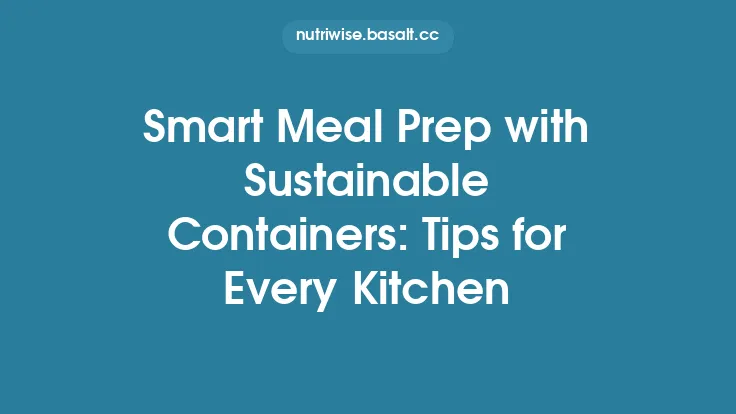Grain bowls have become a staple in modern meal planning because they combine convenience, nutrition, and endless variety in a single, portable container. The “one‑step” concept takes this convenience a notch higher: you start with a single pot, pan, or microwave‑safe dish, add your grain, a handful of add‑ins, and let the heat do the rest. The result is a wholesome, satisfying meal that requires minimal chopping, no separate cooking vessels, and virtually no cleanup. Whether you’re feeding yourself after a quick workout, prepping lunches for the workweek, or looking for a no‑fuss dinner for the whole family, mastering one‑step grain bowls can streamline your kitchen routine while keeping your meals nutritionally balanced and flavorful.
Understanding the One‚ÄëStep Grain Bowl Philosophy
At its core, a one‚Äëstep grain bowl is built around three principles:
- Single‑Vessel Cooking – All components are cooked together, eliminating the need for multiple pots or pans.
- Minimal Prep – Ingredients are used whole or with only the briefest of cuts (e.g., a quick toss of frozen veggies).
- Balanced Nutrition – The bowl includes a grain base, a protein source, vegetables, and a flavor‑enhancing sauce or seasoning.
By adhering to these guidelines, you can create meals in 15‚ÄØminutes or less, even on the busiest of days. The key is selecting ingredients that either cook quickly or are already cooked, and pairing them with flavors that develop during the brief cooking window.
Choosing the Right Grains
Not all grains are created equal when it comes to one‚Äëstep cooking. The ideal grain should:
- Cook Quickly – 5–15 minutes is the sweet spot.
- Absorb Flavors – A porous texture helps sauces and seasonings permeate the bowl.
- Maintain Structure – You want the grain to stay distinct, not turn mushy.
| Grain | Typical Cooking Time (single‚Äëvessel) | Flavor Profile | Best Pairings |
|---|---|---|---|
| Quinoa | 12‚Äë15‚ÄØmin | Mild, slightly nutty | Mediterranean, Mexican |
| Bulgur (fine) | 8‚Äë10‚ÄØmin (no‚Äëboil) | Light, wheat‚Äëlike | Middle‚ÄëEastern, herb‚Äëheavy |
| Millet | 10‚Äë12‚ÄØmin | Sweet, corn‚Äëlike | Asian, curry‚Äëbased |
| Instant Brown Rice | 5‚Äë7‚ÄØmin (microwave) | Earthy | Asian, teriyaki |
| Couscous (traditional) | 5‚Äë6‚ÄØmin (steep) | Delicate, fluffy | North‚ÄëAfrican, lemon‚Äëherb |
| Freekeh | 12‚Äë15‚ÄØmin | Smoky, robust | Mediterranean, roasted veg |
When you’re short on time, keep a small stock of instant or pre‑cooked grains in the pantry or freezer. They can be tossed straight into the pan with the other ingredients, absorbing the broth or sauce as they heat through.
Minimal‚ÄëPrep Cooking Techniques
1. One‚ÄëPot Simmer
Place the grain, liquid (water, broth, or a mix of both), and any quick‚Äëcooking vegetables into a saucepan. Bring to a boil, then reduce to a gentle simmer, covering the pot. The steam will cook the grain while the liquid infuses flavor. Add protein (canned beans, pre‚Äëcooked chicken strips, tofu cubes) midway through the simmer to heat through without overcooking.
2. Microwave “Bowl‑It” Method
Combine grain, liquid, and frozen veggies in a microwave‚Äësafe bowl. Cover loosely with a vented lid or a paper towel. Microwave on high for 3‚Äë5‚ÄØminutes, stir, then continue in 1‚Äëminute bursts until the grain is tender. This method is perfect for office kitchens or when you lack stovetop access.
3. Sheet‑Pan “All‑In‑One” (when you have a minute to preheat)
Spread the grain, a splash of oil, and liquid over a sheet pan. Scatter frozen or pre‑cut veggies and protein on top. Roast at 425 °F for 12‑15 minutes, stirring once. The high heat creates a lightly toasted grain base and caramelized veggies in a single step.
4. Pressure‚ÄëCooker Shortcut
If you own an electric pressure cooker, add grain, liquid, and any sturdy vegetables (e.g., carrots, sweet potatoes). Cook on high pressure for half the usual stovetop time (e.g., 5‚ÄØminutes for quinoa). Quick‚Äërelease, then stir in delicate greens or pre‚Äëcooked protein.
Building a Balanced Bowl
A nutritionally complete grain bowl typically follows a 40‑30‑30 macronutrient split: 40 % carbohydrates (the grain), 30 % protein, and 30 % vegetables/fats. Here’s a quick formula you can adapt:
- Grain Base (½ cup dry) – Provides complex carbs and fiber.
- Protein (¼ cup cooked) – Choose from legumes, canned fish, pre‑cooked meats, or plant‑based alternatives.
- Vegetables (¼ cup) – Frozen mixed veg, fresh baby spinach, shredded cabbage, or quick‑sautéed mushrooms.
- Healthy Fat (1 tsp–1 Tbsp) – Drizzle olive oil, sprinkle nuts/seeds, or stir in avocado at the end.
- Flavor Boost (Sauce/Seasoning) – A spoonful of pesto, a splash of soy‑ginger glaze, or a dollop of yogurt.
By scaling each component proportionally, you can tailor the bowl to specific dietary goals (e.g., higher protein for athletes, lower carbs for low‚Äëglycemic plans) without altering the one‚Äëstep workflow.
Flavor Boosters & Simple Sauces
The magic of a grain bowl lies in its sauce. Because the cooking time is short, the sauce must be both quick to assemble and robust enough to coat the ingredients. Below are three evergreen sauce families that can be mixed in under a minute:
| Sauce Type | Core Ingredients | Quick Prep (≤30 sec) | Pairing Suggestions |
|---|---|---|---|
| Citrus‚ÄëHerb Vinaigrette | Lemon juice, olive oil, minced garlic, chopped parsley, salt & pepper | Whisk together | Quinoa + chickpeas + roasted carrots |
| Soy‚ÄëGinger Glaze | Low‚Äësodium soy sauce, grated ginger, honey or maple syrup, a splash of rice vinegar | Stir in a small bowl | Brown rice + edamame + frozen peas |
| Creamy Yogurt‚ÄëTahini | Greek yogurt, tahini, lemon zest, a pinch of cumin, water to thin | Blend with a fork | Millet + grilled chicken strips + spinach |
| Spicy Peanut Drizzle | Peanut butter, sriracha, lime juice, warm water, a dash of soy sauce | Whisk until smooth | Couscous + tofu cubes + broccoli florets |
| Pesto‚ÄëInfused Oil | Store‚Äëbought pesto, extra‚Äëvirgin olive oil | Mix 1:2 ratio | Bulgur + roasted zucchini + feta crumbles |
Keep a small “sauce station” in your fridge: a few jars of base sauces (soy sauce, tahini, pesto) and a selection of fresh aromatics (lemon, garlic, ginger). This setup lets you assemble a new flavor profile in seconds, keeping the bowls exciting day after day.
Customizing for Dietary Needs
One‚Äëstep grain bowls are inherently adaptable. Below are common dietary modifications and the minimal‚Äëprep swaps that keep the workflow intact:
| Need | Grain Swap | Protein Swap | Veg Swap | Fat/Sauce Adjustments |
|---|---|---|---|---|
| Gluten‚ÄëFree | Quinoa, millet, brown rice | Canned salmon, tempeh, lentils | Fresh or frozen veggies (all are gluten‚Äëfree) | Use tamari instead of soy sauce |
| Vegan | Any plant‑based grain | Chickpeas, black beans, tofu, tempeh | All veg + nutritional yeast for “cheesy” note | Coconut‑based sauces, avocado oil |
| Low‚ÄëCarb | Cauliflower rice (pre‚Äëriced) | Eggs, grilled shrimp, turkey sausage | Leafy greens, zucchini, bell peppers | Butter or ghee for richness |
| High‚ÄëProtein | Farro (higher protein) or quinoa | Pre‚Äëcooked chicken breast, canned tuna, edamame | Add a handful of beans or peas | Greek yogurt‚Äëbased sauces |
| Low‚ÄëSodium | Use water or low‚Äësodium broth | Unsalted nuts, plain beans | Fresh veg (no canned) | Limit soy sauce; use herbs & citrus |
Because the cooking method remains the same—single vessel, short time—these swaps never add extra steps, only different ingredients.
Meal Prep & Storage Strategies
Even though the bowls are designed for “instant” assembly, having a few staples ready can shave seconds off your routine:
- Batch‑Cook Grains – Cook a large pot of quinoa or brown rice on the weekend. Portion into zip‑top bags, let cool, then freeze. A ½‑cup portion thaws in the microwave in 1‑2 minutes.
- Pre‑Portion Proteins – Divide canned beans, cooked chicken, or tofu into single‑serve containers. This eliminates measuring each time.
- Veggie Packs – Keep frozen mixed vegetables in individual freezer bags. For fresh options, wash and chop greens, carrots, or bell peppers, then store in airtight containers with a paper towel to absorb moisture.
- Sauce Mini‑Jars – Fill small mason jars with your favorite sauces. They stay fresh for weeks and can be poured directly into the bowl.
- Labeling System – Use a color‑coded sticker system (e.g., green for vegan, blue for high‑protein) on your containers. This visual cue speeds up selection and reduces decision fatigue.
Storage Tips:
- Refrigerated bowls (no sauce) keep 3‚Äë4‚ÄØdays. Add sauce just before eating to prevent sogginess.
- Freezer‚Äësafe bowls (grain + protein + veg, no fresh greens) last up to 2‚ÄØmonths. Thaw overnight in the fridge or microwave directly from frozen, then stir in fresh toppings.
- Avoid over‚Äëliquefying: When reheating, add a splash of broth or water if the bowl looks dry; the grain will re‚Äëabsorb moisture.
Troubleshooting Common Issues
| Problem | Likely Cause | Quick Fix |
|---|---|---|
| Grain is under‑cooked | Insufficient liquid or too high heat | Add ¼ cup more liquid, cover, and simmer 2‑3 minutes longer |
| Grain is mushy | Too much liquid or over‚Äëcooking | Use a 1:1.5 grain‚Äëto‚Äëliquid ratio next time; reduce simmer time |
| Sauce separates | High heat or too much oil | Remove from heat, whisk vigorously; add a splash of water to emulsify |
| Veggies are soggy | Added too early or using high‚Äëwater‚Äëcontent veg | Toss frozen veg in at the same time as grain; for fresh veg, add during the last minute of cooking |
| Bowl lacks flavor | Not enough seasoning or sauce | Increase sauce ratio to 2‚Äë3‚ÄØTbsp per bowl; finish with a pinch of salt or a squeeze of citrus |
A simple rule of thumb: Taste as you go. Even with a one‚Äëstep approach, a quick spoonful halfway through cooking can alert you to seasoning needs before the dish is finished.
Scaling Up & Batch Cooking
When feeding a family or prepping for the week, the one‚Äëstep concept still shines:
- Double‑Up the Pot – Use a larger stockpot or a wide‑bottomed sauté pan. The grain‑to‑liquid ratio stays the same; just increase the volume.
- Layering Technique – Place the grain and liquid at the bottom, then layer sturdier vegetables (carrots, sweet potatoes) on top, followed by quicker‑cooking veg and protein. The steam from the grain will gently cook the lower layers, while the top items receive direct heat.
- Stir‑Once Method – After the initial stir to combine grain and liquid, let the mixture sit undisturbed. This encourages a light crust on the bottom (a pleasant texture) while preventing over‑mixing, which can make the grain gummy.
- Portion Control – Use a kitchen scale or measuring cup to allocate equal portions into containers. This ensures consistent nutrition across meals.
Batch cooking also opens the door to flavor cycling: prepare a base of quinoa with broth, then create three distinct sauces (e.g., lemon‑herb, spicy peanut, soy‑ginger) to keep each day’s bowl unique without extra cooking time.
Sustainable & Budget‚ÄëFriendly Practices
- Buy Grains in Bulk – Large bags of quinoa, brown rice, or millet are cheaper per pound and reduce packaging waste.
- Utilize Frozen Veg – Frozen vegetables retain nutrients, cost less, and eliminate prep time.
- Canned Legumes – Rinse to reduce sodium; they’re a protein powerhouse that requires no cooking.
- DIY Sauces – A simple blend of olive oil, lemon, and herbs can replace store‑bought dressings, saving money and reducing additives.
- Leftover Reinvention – Turn yesterday’s bowl into today’s stir‑fry by adding a splash of broth and a quick sauté, or blend into a soup for a new texture.
By focusing on pantry staples and versatile ingredients, you can keep the cost per bowl under $2 while still delivering a nutritionally complete meal.
Final Tips for Success
- Prep the Liquid First – Warm broth or water before adding the grain; this jump‑starts the cooking process.
- Mind the Heat – A gentle simmer is often better than a rolling boil; it prevents grain from breaking apart.
- Add Fresh Elements at the End – A handful of arugula, a drizzle of avocado oil, or a sprinkle of feta adds brightness without extra cooking.
- Keep a “Flavor Card” – Write down your favorite sauce ratios on a small index card and stick it on the fridge. When you’re in a rush, you’ll have the perfect blend at a glance.
- Enjoy the Process – The beauty of one‑step grain bowls is their simplicity. Embrace the minimalism, experiment with new combos, and let the bowl become a canvas for whatever ingredients you have on hand.
With these strategies in place, you’ll be able to whip up nourishing, delicious grain bowls in a single step, every day of the week, without sacrificing flavor, nutrition, or your precious time. Happy bowl‑building!





